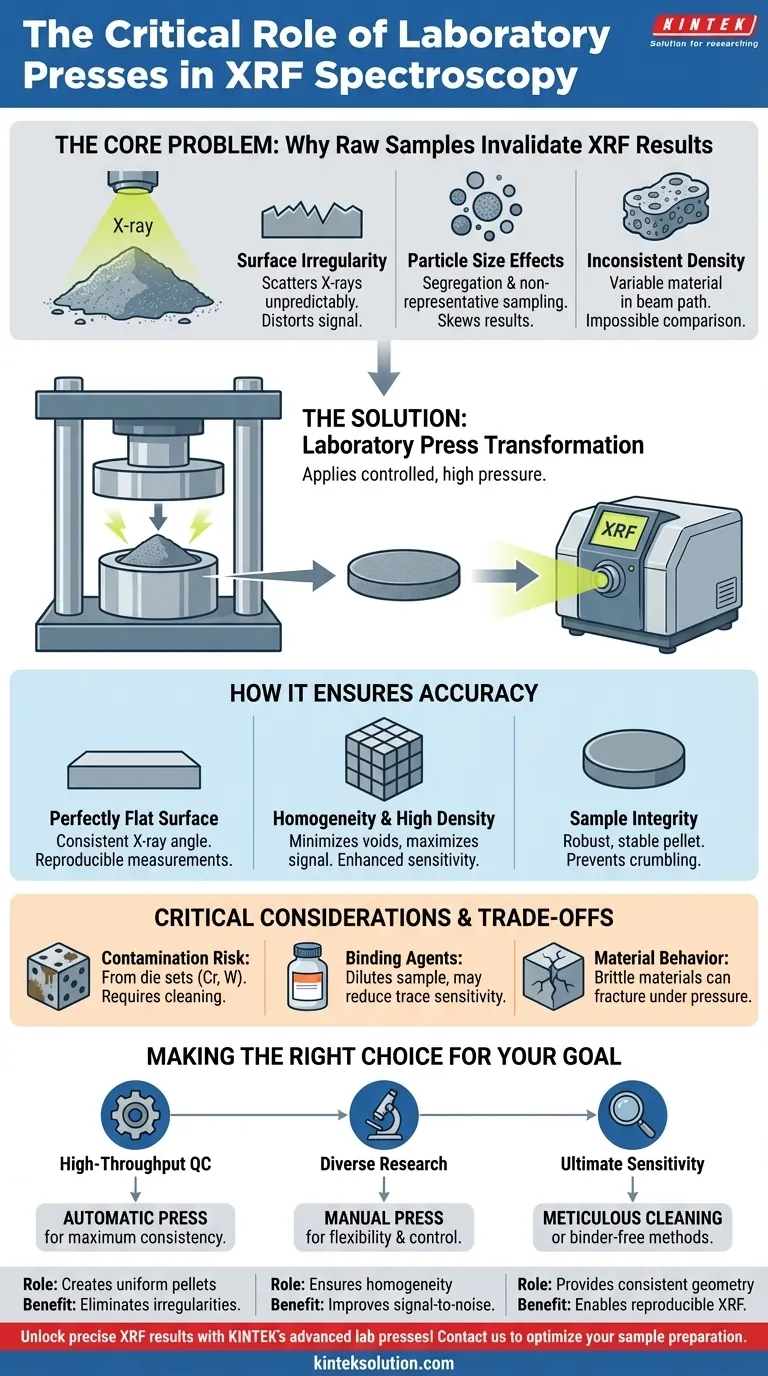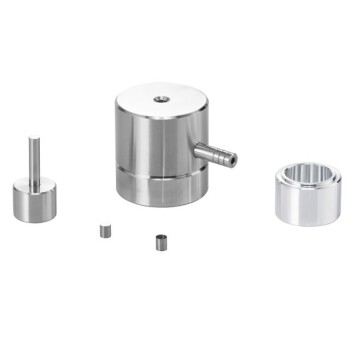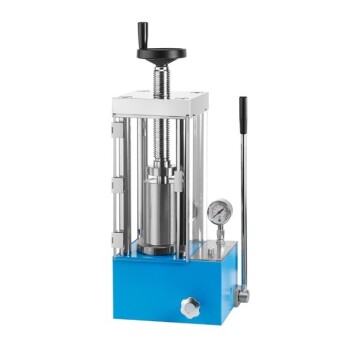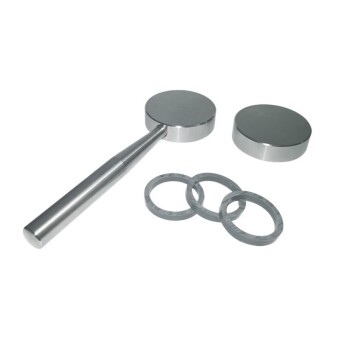In X-ray fluorescence (XRF) spectroscopy, a laboratory press is the critical tool used to convert loose powders or granular materials into dense, solid pellets with a uniform surface. This process of pelletizing is not a minor preliminary step; it is a foundational requirement for obtaining accurate and repeatable elemental analysis. By creating a standardized sample form, the press eliminates major sources of measurement error.
An XRF spectrometer is only as good as the sample presented to it. The primary role of a laboratory press is to remove physical inconsistencies from a sample—such as uneven surfaces, voids, and particle size variations—to ensure the X-ray signal reflects only the material's true chemical composition.
The Core Problem: Why Raw Samples Invalidate XRF Results
Analyzing a loose powder or an irregularly shaped solid with XRF introduces significant uncertainty. The physics of X-ray interaction demands a highly controlled sample geometry to produce reliable data.
The Issue of Surface Irregularity
An uneven sample surface acts like a fractured mirror for the X-ray beam. It causes the incident X-rays to scatter unpredictably and the emitted fluorescent X-rays to be absorbed inconsistently before they reach the detector.
This results in a distorted signal that does not accurately represent the elements present in the sample.
The Challenge of Particle Size Effects
In a loose powder, fine and coarse particles can segregate, meaning the portion of the sample hit by the X-ray beam may not be representative of the whole.
Furthermore, X-rays can be scattered or absorbed differently by particles of varying sizes, an issue known as the "particle size effect," which skews quantitative results.
The Problem of Inconsistent Density
A loose powder is full of air gaps and has a low, non-uniform bulk density. This means the amount of actual material in the path of the X-ray beam is inconsistent.
This variability directly impacts the intensity of the fluorescent signal, making it impossible to compare one sample to another or to a calibration standard with any confidence.
How a Laboratory Press Solves for Accuracy
A hydraulic or manual lab press systematically eliminates these physical variables by applying controlled, high pressure to the sample within a die set.
Creating a Perfectly Flat and Uniform Surface
The press compacts the powder into a pellet with a smooth, perfectly flat analytical surface. This ensures the X-ray beam irradiates the sample at a consistent angle.
This geometric consistency is the first and most critical step toward reproducible measurements.
Achieving Homogeneity and High Density
Pressing forces the individual particles together, minimizing voids and significantly increasing the sample's density. This process creates a homogenous sample matrix.
A dense, homogenous pellet reduces X-ray scattering and maximizes the fluorescent signal returning to the detector, which enhances measurement sensitivity and improves the signal-to-noise ratio.
Ensuring Sample Integrity
The resulting pellet is a robust, solid disc that is easy to handle and stable under the vacuum conditions sometimes used in XRF instruments.
This physical integrity prevents the sample from crumbling or shifting during analysis, ensuring the measurement is performed on the same material throughout the acquisition time.
Understanding the Trade-offs and Considerations
While essential, the pellet pressing process is not without factors that require careful management to ensure the highest quality data.
The Risk of Contamination
The die set used to form the pellet can, over time, introduce trace element contamination if not cleaned properly. This is especially critical when analyzing for elements present in the steel of the die itself, such as chromium (Cr) or tungsten (W) from tungsten carbide.
The Use of Binding Agents
Some materials do not form stable pellets on their own and require a binding agent or grinding aid (like a wax or cellulose) to be mixed in.
While necessary for pellet integrity, the binder inherently dilutes the sample, which can reduce the sensitivity for trace elements. The binder must also be free of any elements you intend to measure.
Material Behavior Under Pressure
Not all materials respond well to high pressure. Brittle materials can fracture, and certain crystalline structures can undergo phase changes, which may alter the XRF measurement in subtle ways. Understanding your material is key.
Making the Right Choice for Your Goal
Proper sample preparation is the foundation of reliable XRF analysis. Your pressing strategy should align with your analytical objectives.
- If your primary focus is high-throughput quality control: An automatic press is superior, as it provides maximum consistency and reproducibility with minimal operator variability.
- If your primary focus is research on diverse materials: A manual press offers greater flexibility, allowing you to carefully control the pressure ramp and adapt the method for delicate or unusual samples.
- If your primary focus is ultimate sensitivity for trace elements: Meticulous cleaning of the die set is paramount, and you should explore binder-free pressing methods or use a binder you have verified to be contaminant-free.
Ultimately, mastering the use of a laboratory press transforms sample preparation from a routine task into a powerful method for ensuring your XRF data is both accurate and trustworthy.
Summary Table:
| Role of Laboratory Press | Key Benefit |
|---|---|
| Creates uniform pellets | Eliminates surface irregularities and density variations |
| Ensures sample homogeneity | Reduces particle size effects and improves signal-to-noise ratio |
| Provides consistent geometry | Enables reproducible and reliable XRF measurements |
| Enhances sample integrity | Prevents crumbling under vacuum and handling issues |
Unlock precise and reliable XRF results with KINTEK's advanced lab press machines! Whether you're in quality control or research, our automatic lab presses, isostatic presses, and heated lab presses deliver consistent, high-density pellets to eliminate errors and boost sensitivity. Contact us today to discuss how our solutions can optimize your laboratory's sample preparation and enhance your analytical outcomes.
Visual Guide

Related Products
- Automatic Laboratory Hydraulic Press Lab Pellet Press Machine
- Manual Laboratory Hydraulic Press Lab Pellet Press
- Manual Heated Hydraulic Lab Press with Integrated Hot Plates Hydraulic Press Machine
- Laboratory Hydraulic Press 2T Lab Pellet Press for KBR FTIR
- Automatic Laboratory Hydraulic Press for XRF and KBR Pellet Pressing
People Also Ask
- What are the advantages of using a hydraulic press for pellet production? Achieve Consistent, High-Quality Samples
- What feature of the hydraulic portable press helps monitor the pellet-making process? Discover the Key to Precise Sample Preparation
- How do hydraulic press machines ensure precision and consistency in pressure application? Achieve Reliable Force Control for Your Lab
- How does a hydraulic press aid in XRF spectroscopy? Achieve Accurate Elemental Analysis with Reliable Sample Prep
- What is the purpose of creating pellets for XRF spectroscopy using a hydraulic press? Ensure Accurate and Repeatable Elemental Analysis



















